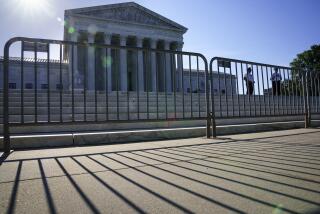Cameras Could Get Rolling on High Court Sessions
- Share via
WASHINGTON — With the Supreme Court nomination process for Judge Samuel A. Alito Jr. on hold until hearings in early January, the Senate Judiciary Committee changed course Wednesday to address whether sessions of the court Alito hopes to join should be televised.
Sen. Arlen Specter (R-Pa.), the committee’s chairman, told a hearing that opening the Supreme Court to television coverage would be “an enormously useful tool for public understanding” and would allow the American people to properly evaluate how their government functions.
Under his proposal, which he introduced last month, cameras would be removed only if a majority of the justices determined that their presence would undermine the due process of a litigant in a specific case.
The Supreme Court makes audio recordings of its proceedings, but releases them immediately only on rare occasions -- such as after the arguments in Bush vs. Gore, the case that decided the 2000 presidential election.
In addition to Specter’s legislation, the panel also considered a broader bill first introduced by Sen. Charles E. Grassley (R-Iowa) in 2001 and reintroduced again this year.
Dubbed the “Sunshine in the Courtroom Act,” Grassley’s bill would allow the presiding judge of a specific case to decide whether video devices would be permitted during sessions in federal district and appellate courts.
Coincidentally on Wednesday, the House, by a vote of 375 to 45, passed courtroom security legislation that would give federal judges the option of having proceedings in their courtrooms televised. The White House has already announced opposition to the proposal, contending that televising court sessions could influence the proceedings and compromise the security of witnesses.
Within the California delegation, Democrats Bob Filner (Chula Vista), Barbara Lee (Oakland), George Miller (Martinez), Lucille Roybal-Allard (East Los Angeles), Hilda L. Solis (El Monte), Pete Stark (Fremont), Maxine Waters (Los Angeles), Henry A. Waxman (Los Angeles) and Lynn Woolsey (Petaluma) were opposed; all other delegation members were in favor.
According to the administrative office of the federal court system, appellate courts can set their own policies regarding television coverage, and the ones in New York and San Francisco have voted to permit cameras. No cameras are permitted in federal district courts.
State courts in all 50 states allow cameras, generally at the appellate level, said Henry S. Schieff of the cable network Court TV, which frequently televises trials. In 43 states, he said, cameras are permitted in trial courts -- “and of those, 39 states permit cameras in their criminal trial courts.... There is, clearly, a growing consensus that having cameras in courtrooms serves the public interest.”
The public affairs network C-SPAN broadcasts gavel-to-gavel coverage of House and Senate floor sessions, and the network’s Chairman and Chief Executive Brian P. Lamb told the Judiciary Committee that he had written to Chief Justice John G. Roberts Jr. offering similar coverage of the high court.
“The judiciary has become the invisible branch of our national government as far as television news coverage is concerned -- and, increasingly, as far as the public is concerned,” Lamb said.
Although there was general support in the hearing for allowing cameras in the Supreme Court and federal appellate courts, there was more resistance when it came to trials in federal district court.
Sen. Jeff Sessions (R-Ala.) expressed the strongest reservations, arguing that cameras could significantly undermine the comfort and cooperation of key witnesses in criminal trials.
“Trials are crucibles for truth, not entertainment,” Sessions said.
Also opposing coverage of federal criminal trials was U.S. District Judge Jan E. DuBois of Philadelphia. DuBois expressed concern that the media would not televise entire trials, instead showing brief segments that could potentially distort the actual events.
“In such a setting, the camera is likely to do more than report a proceeding -- it is likely to influence the substance of the proceeding,” he said.
Barbara Cochran, president of the Radio-Television News Directors Assn., vehemently defended cameras in courts, saying that allowing the public to see what goes on instills greater public trust in the judicial process.
“It is simply not right that Americans form their opinions about how our judicial system functions based on what they see and hear on the latest episode of ‘Judge Judy’ or ‘CSI,’ ” she said. “Nor does it make sense that the nominees for the Supreme Court are widely seen in televised hearings conducted by this committee, only to disappear from public view the moment they are sworn in as justices.”
During his confirmation hearings in September, Roberts told the Judiciary Committee that he didn’t have a “settled view” on the issue of cameras in the Supreme Court. But other justices, including David H. Souter and Antonin Scalia, have declared their outright opposition to the idea.
Scalia has asked for the removal of cameras and other recording equipment before making public addresses. And in 1996, Souter told a House Appropriations subcommittee: “The day you see a camera come into our courtroom, it’s going to roll over my dead body.”
More to Read
Get the L.A. Times Politics newsletter
Deeply reported insights into legislation, politics and policy from Sacramento, Washington and beyond. In your inbox twice per week.
You may occasionally receive promotional content from the Los Angeles Times.










